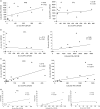The relationship between human effector and memory T cells measured by ex vivo and cultured ELISPOT following recent and distal priming
- PMID: 19689738
- PMCID: PMC2747141
- DOI: 10.1111/j.1365-2567.2009.03073.x
The relationship between human effector and memory T cells measured by ex vivo and cultured ELISPOT following recent and distal priming
Erratum in
- Immunology. 2011 Apr;132(4):589
Abstract
Maintenance of T-cell responses is an essential feature in protection from many infectious diseases that must be harnessed in vaccination. The relationship between effector T-cell responses and more durable and highly proliferative T-cell memory, particularly in humans, is not well understood. In this study, effector T-cell responses were measured by overnight ex vivo interferon-gamma (IFN-gamma) enzyme-linked immunosorbent spot-forming cell assay (ELISPOT), whereas memory T cells were measured by 10-day culture followed by IFN-gamma ELISPOT (cultured ELISPOT). We observed a significant correlation between IFN-gamma responses to CD4-stimulatory, but not to CD8-stimulatory, recall antigens measured by these assays, suggesting a divergence in regulation. In vaccine trial participants who received a prime-boost vaccination regimen comprising malaria antigens delivered by poxviruses, there was a correlation between ex vivo and cultured responses on day 7, but not 3 months post-vaccination, with the ratio of cultured : ex vivo response increasing over time. To compare responses revealed by cultured ELISPOT in more detail, tetramers comprising viral recall antigens were used to ascribe effector-memory and central-memory T-cell phenotypes through CCR7 and CD62L costaining. For CD8(+) responses the effector phenotype decreased during the initial culture period and memory populations remained high within the resulting 20-fold to 50-fold increased IFN-gamma-secreting or tetramer(+) population. This was less marked for CD4(+) responses, which had higher starting memory phenotype. Depletion of these central-memory T-cell populations generally ablated responses in cultured ELISPOT and reduced ex vivo responses. This study highlights differences between CD4(+) and CD8(+) effector and memory T cells, and the more complex phenotype of CD4(+) T cells.
Figures






Similar articles
-
Early gamma interferon and interleukin-2 responses to vaccination predict the late resting memory in malaria-naïve and malaria-exposed individuals.Infect Immun. 2006 Nov;74(11):6331-8. doi: 10.1128/IAI.00774-06. Epub 2006 Sep 11. Infect Immun. 2006. PMID: 16966412 Free PMC article.
-
Durable human memory T cells quantifiable by cultured enzyme-linked immunospot assays are induced by heterologous prime boost immunization and correlate with protection against malaria.J Immunol. 2005 Nov 1;175(9):5675-80. doi: 10.4049/jimmunol.175.9.5675. J Immunol. 2005. PMID: 16237057
-
Long-term central and effector SHIV-specific memory T cell responses elicited after a single immunization with a novel lentivector DNA vaccine.PLoS One. 2014 Oct 22;9(10):e110883. doi: 10.1371/journal.pone.0110883. eCollection 2014. PLoS One. 2014. PMID: 25337803 Free PMC article.
-
Correlation of memory T cell responses against TRAP with protection from clinical malaria, and CD4 CD25 high T cells with susceptibility in Kenyans.PLoS One. 2008 Apr 30;3(4):e2027. doi: 10.1371/journal.pone.0002027. PLoS One. 2008. PMID: 18446217 Free PMC article.
-
Ex vivo IFN-gamma secretion by circulating CD8 T lymphocytes: implications of a novel approach for T cell monitoring in infectious and malignant diseases.J Immunol. 2001 Jun 15;166(12):7634-40. doi: 10.4049/jimmunol.166.12.7634. J Immunol. 2001. PMID: 11390521
Cited by
-
Application of Long-term cultured Interferon-γ Enzyme-linked Immunospot Assay for Assessing Effector and Memory T Cell Responses in Cattle.J Vis Exp. 2015 Jul 11;(101):e52833. doi: 10.3791/52833. J Vis Exp. 2015. PMID: 26275095 Free PMC article.
-
Memories that last forever: strategies for optimizing vaccine T-cell memory.Blood. 2010 Mar 4;115(9):1678-89. doi: 10.1182/blood-2009-06-227546. Epub 2009 Nov 10. Blood. 2010. PMID: 19903895 Free PMC article. Review.
-
Enumeration and characterization of human memory T cells by enzyme-linked immunospot assays.Clin Dev Immunol. 2013;2013:637649. doi: 10.1155/2013/637649. Epub 2013 Nov 11. Clin Dev Immunol. 2013. PMID: 24319467 Free PMC article. Review.
-
Optimisation of the cultured ELISpot/Fluorospot technique for the selective investigation of SARS-CoV-2 reactive central memory T cells.Front Immunol. 2025 Apr 15;16:1547220. doi: 10.3389/fimmu.2025.1547220. eCollection 2025. Front Immunol. 2025. PMID: 40303392 Free PMC article.
-
Immunological hallmarks of JC virus replication in multiple sclerosis patients on long-term natalizumab therapy.J Virol. 2013 May;87(10):6055-9. doi: 10.1128/JVI.00131-13. Epub 2013 Mar 20. J Virol. 2013. PMID: 23514886 Free PMC article.
References
-
- Sallusto F, Lenig D, Forster R, Lipp M, Lanzavecchia A. Two subsets of memory T lymphocytes with distinct homing potentials and effector functions. Nature. 1999;401:708–12. - PubMed
-
- Sallusto F, Geginat J, Lanzavecchia A. Central memory and effector memory T cell subsets: function, generation, and maintenance. Annu Rev Immunol. 2004;22:745–63. - PubMed
-
- Wherry EJ, Teichgraber V, Becker TC, Masopust D, Kaech SM, Antia R, von Andrian UH, Ahmed R. Lineage relationship and protective immunity of memory CD8 T cell subsets. Nat Immunol. 2003;4:225–34. - PubMed
-
- Khan N, Best D, Bruton R, Nayak L, Rickinson AB, Moss PA. T cell recognition patterns of immunodominant cytomegalovirus antigens in primary and persistent infection. J Immunol. 2007;178:4455–65. - PubMed
-
- Reiner SL, Sallusto F, Lanzavecchia A. Division of labor with a workforce of one: challenges in specifying effector and memory T cell fate. Science. 2007;317:622–5. - PubMed
Publication types
MeSH terms
Substances
Grants and funding
LinkOut - more resources
Full Text Sources
Other Literature Sources
Research Materials

